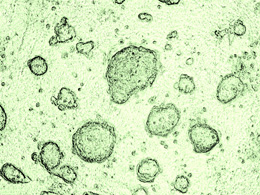19 February 2013
 The University of South Australia will lead a new Cooperative Research Centre for Cell Therapy Manufacturing set to underpin significant innovations in the treatment available for diabetes, wounds, and transplant patients. The CRC represents a $59 million investment in cash and in-kind support from the Federal Government ($20M) and14 CRC industry and organisational partners.
The University of South Australia will lead a new Cooperative Research Centre for Cell Therapy Manufacturing set to underpin significant innovations in the treatment available for diabetes, wounds, and transplant patients. The CRC represents a $59 million investment in cash and in-kind support from the Federal Government ($20M) and14 CRC industry and organisational partners.
Head of the new CRC, UniSA’s Professor Rob Short, says the goal of the research over the next six years will be to bed down a new cell therapy manufacturing industry in SA and create hundreds of new jobs, many in advanced manufacturing.
“Twenty years ago Australia was at the vanguard of research into cell therapy and transplant medicine and technology, but to keep ahead in the application of these wonderful possibilities, they need to be underpinned by advanced manufacturing and materials science technology,” Prof Short says.
“The advantage of the CRC model is that it is dynamic - scientists can work in-step with industry and much closer to where their science will be applied, so that there is constant communication about what works and what doesn’t.”
Prof Short says the CRC for Cell Therapy Manufacturing, to be headquartered at UniSA’s Mawson lakes campus, will bring together materials scientists, cell biologists, bioprocess engineers, clinicians and industry to increase the affordability and accessibility of cell therapies and position Australia at the leading edge of cell therapy manufacture.
“Cell therapies offer exciting new possibilities for a range of previously incurable and difficult-to-treat medical conditions including Type 1 diabetes which affects more than 100,000 Australians.
“They will also provide a platform for healing life-threatening ischemic foot wounds and progress a new technology for organ transplants that could negate the need for immunosuppressive drugs, based upon special cells known as T-regs, which can “police” the immune system.
“We aim to undertake the first “in man” trails for a new islet transplantation technology with a goal to eliminate the need for daily injections of insulin for Type 1 diabetes sufferers.”
He says the CRC will focus on developing interventions with smart materials and surfaces to facilitate the cost-effective manufacture and rapid translation of cell therapies into clinical practice.
UniSA Vice Chancellor Professor David Lloyd says the successful bid to establish the CRC is wonderful news for the University and the State.
“This is a significant area of research that will feed the development of a world-class manufacturing base in South Australia in an area of great benefit locally and globally,” Prof Lloyd said.
“It represents exactly the kind of university, government and industry partnership that stimulates relevant innovation and I am delighted that UniSA will play a leading role here in developing health treatments that will make a difference.”
The CRC will comprise local, national and global manufacturers, researchers from the Queensland University of Technology and Sydney University and from the Royal Adelaide Hospital and St. Vincent’s Institute and Westmead Hospital and some key charities. Its headquarters will be at UniSA’s $50M Materials and Minerals Science Building which was opened in 2012 at Mawson Lakes.
Media contact
Michèle Nardelli office: 08 8302 0966 mobile: 0418 823 673 email: michele.nardelli@unisa.edu.au




